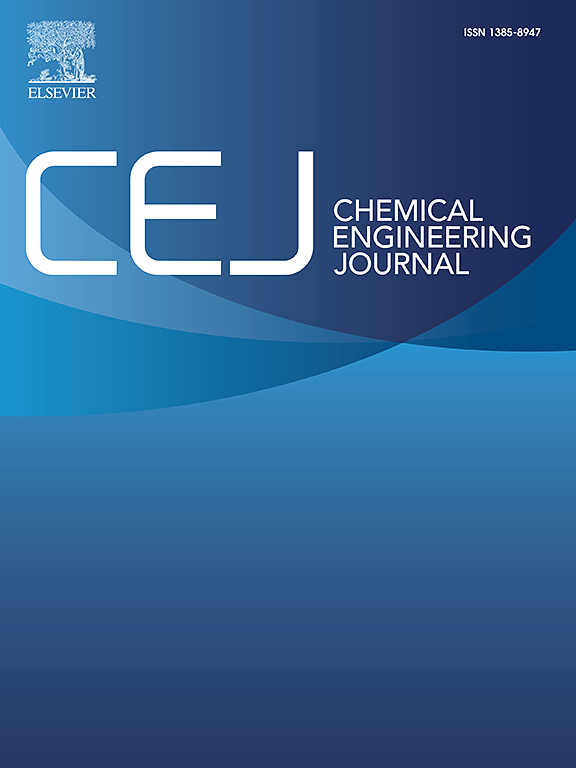Optimizing mass flow and extracellular electron transfer to promote energy recovery during treating municipal wastewater in a biochar enhanced anaerobic membrane bioreactor (AnMBR)
IF 13.3
1区 工程技术
Q1 ENGINEERING, CHEMICAL
引用次数: 0
Abstract
The anaerobic membrane bioreactor (AnMBR) is an alternative technology with energy neutrality potential when treating municipal wastewater (MWW). However, the poor bio-reaction kinetic conditions caused by low COD concentrations in MWW greatly limits the CH yield. In this study, the average methanogenesis rate was significantly increased from 164.8 to 275.5 mL/g COD with the two times biochar addition of 5 g/L. And following the second time addition of 5 g/L biochar, the CH component significantly increased to a high level of 89.0 ± 6.3 %. In addition, the rate for acetate converted into CH increased from 3.3 to 10.5 mmol/(g ·d) with biochar addition of 10 g/L, indicating that acetotrophic methanogenesis route was significantly promoted by biochar. Bio-electrochemistry analysis showed that biochar accelerated 0.74 mol e/g /min of electron transfer velocity in AD system. The addition of biochar enriched organic metabolism bacteria such as , and , and upregulated the expression of functional genes related to organics degradation such as , and facilitates the direct transfer of electrons and acetates produced by and r to convert CO into CH through microbial mediation. Thus, the COD flow shifted significantly towards more CH production. The COD mass flow showed that biochar facilitated more bio-catabolism (up about 52.7 %) and less bio-anabolism (down about 92 %), and more COD in wastewater was converted to CH, resulting a significant promoting of energy production. The energy balance analysis indicated that the net energy consumption was reduced by 15 % after two times addition of 5 g/L biochar, and the key to achieve the net energy output during treating MWW is the efficient operation of AnMBR at ambient temperature.在生物炭强化厌氧膜生物反应器(AnMBR)处理城市污水的过程中,优化质量流和胞外电子传递以促进能量回收
在处理城市污水(MWW)时,厌氧膜生物反应器(AnMBR)是一种具有能源中和潜力的替代技术。然而,由于 MWW 中的 COD 浓度较低,导致生物反应动力学条件较差,大大限制了甲烷产量。在这项研究中,两次添加 5 克/升生物炭后,平均甲烷生成率从 164.8 毫升/克 COD 显著提高到 275.5 毫升/克 COD。第二次添加 5 克/升生物炭后,CH 成分明显增加到 89.0 ± 6.3 % 的高水平。此外,添加 10 克/升生物炭后,乙酸转化为 CH 的速率从 3.3 mmol/(g -d)增加到 10.5 mmol/(g-d),表明生物炭显著促进了乙酸养甲烷生成途径。生物电化学分析表明,生物炭加快了 AD 系统中 0.74 mol e/g /min 的电子传递速度。生物炭的加入富集了有机代谢菌,如、和,并提高了与有机物降解相关的功能基因的表达,如、和,促进了电子和乙酸盐的直接转移,并通过微生物的中介将 CO 转化为 CH。因此,COD 流量明显转向产生更多的 CH。COD 质量流显示,生物炭促进了更多的生物分解(增加了约 52.7%)和更少的生物新陈代谢(减少了约 92%),废水中更多的 COD 被转化为 CH,从而显著促进了能量的产生。能量平衡分析表明,在两次添加 5 克/升生物炭后,净能耗降低了 15%,而在处理中水回用过程中实现净能量产出的关键在于 AnMBR 在环境温度下的高效运行。
本文章由计算机程序翻译,如有差异,请以英文原文为准。
求助全文
约1分钟内获得全文
求助全文
来源期刊

Chemical Engineering Journal
工程技术-工程:化工
CiteScore
21.70
自引率
9.30%
发文量
6781
审稿时长
2.4 months
期刊介绍:
The Chemical Engineering Journal is an international research journal that invites contributions of original and novel fundamental research. It aims to provide an international platform for presenting original fundamental research, interpretative reviews, and discussions on new developments in chemical engineering. The journal welcomes papers that describe novel theory and its practical application, as well as those that demonstrate the transfer of techniques from other disciplines. It also welcomes reports on carefully conducted experimental work that is soundly interpreted. The main focus of the journal is on original and rigorous research results that have broad significance. The Catalysis section within the Chemical Engineering Journal focuses specifically on Experimental and Theoretical studies in the fields of heterogeneous catalysis, molecular catalysis, and biocatalysis. These studies have industrial impact on various sectors such as chemicals, energy, materials, foods, healthcare, and environmental protection.
 求助内容:
求助内容: 应助结果提醒方式:
应助结果提醒方式:


